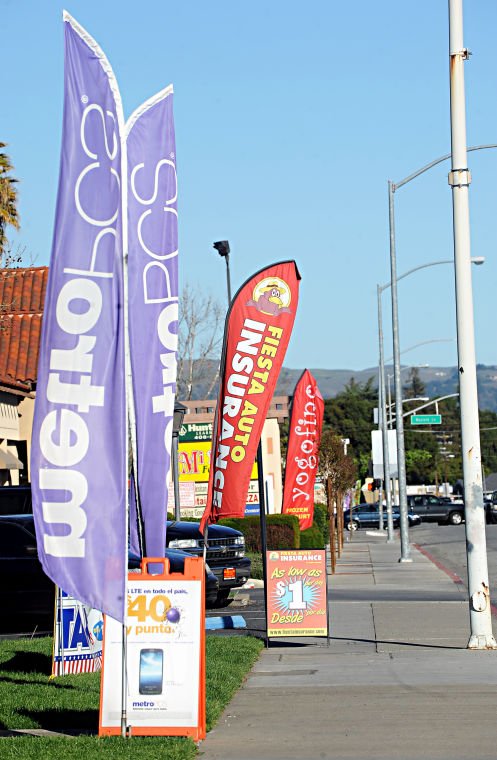
Following a recent about-face on a sign ordinance that banned a variety of signage, City Council agreed July 1 it should not be enforced in earnest until an alternative—presented by local business owners and residents—is formally considered.
The decision comes after a recent study session, when an organized group of Gilroyans asked the council to take a step back and allow professionally designed A-frame signs, handheld signs, banners and costumed advertisers—all restricted by the current ordinance.
The group requested the council consider requiring uniformity of the height and type of A-frame signs based on a business’s location to address the council’s concerns that the Gilroy’s signs needed a thorough cleaning.
At the July 1 meeting, City Council designated enforcement of the ordinance, only as it relates to A-frame signs, banners and handheld signs, as low priorities for the City’s code enforcement officers.
“We like the designs we saw,” Mayor Don Gage said, referring to the A-frame designs the collective presented at the June 9 study session.
Throughout the downtown historic district, the collective suggested the City require metal A-frames to create a sense of uniformity and tall white plastic A-frames elsewhere in Gilroy.
City employees are expected to review all of the collective’s recommendations, including allowing costumed advertisers if businesses are contractually obligated to use them, and present their analysis to the council Aug. 18.
Though the City has not hired the two-part time code enforcement officers requested by the council, the ordinance can still be enforced—particularly if business owners go overboard, according to Community Development Director Kristi Abrams.
“Should someone take advantage of the low priorities or should there be intrusions into the (Americans with Disabilities Act) or safety concerns, we can still go out and address those issues under our current ordinance,” Abrams said.
Business owners who violate the sign ordinance, aside from the grace period for A-frames, banners and handheld signs, will receive an administrative citation. If, after 10 days, the signage is still there and this is the first violation, the business owner will be fined $100. Under the ordinance, frequent violators can be fined $500.
The collective was born after council passed the ordinance on first reading March 17, when no members of the public spoke out during the allotted comment period. At the next meeting, nine business owners and residents balked at the City suffocating what they called the most effective and affordable type of advertising.
In the following weeks, Gilroy’s Fiesta Auto Insurance franchise owners, Barbara and John Rubio, electrified a campaign to change the law. Under the ordinance, the most effective form of advertising—that accounts for 70 to 80 percent of the company’s business, would be banned.
Since the Rubios first opened Fiesta’s doors in July 2010, they’ve employed a man who dresses as the company’s crow mascot and waves at passing cars. Costumed advertisers are explicitly prohibited from standing on public property, the ordinance reads.
Three days after the sign ordinance was passed on final reading, Barbara said she prayed for help fighting it.
“After people read the paper—and after praying that morning—I walked into my office and two people came in back-to-back and said ‘I want to help you’,” Barbara said.
Multiple phone calls followed later that day from more people offering her assistance.
Local community activist Bob Sigala soon joined the group and has been going door-to-door raising awareness about the ordinance—and the collective continues to grow.
“The more outreach we do, the more people will realize it will affect them,” Sigala said.
Elsa LeDon, owner of the Queen of Hearts Boutique located at 7434 Monterey St., said she’s thankful the council is receptive to changing the law and incorporating the group’s signage standards and addendums.
“I’m very appreciative I live in a city where the council members welcomed our proposals and our recommendations,” LeDon said. “It seems positive that we can work with the City or that the City is even open to accepting our recommendations; that shows a big change with the City.”













